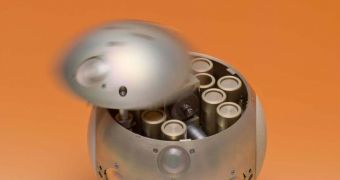Officials with the European Space Agency (ESA) announce the development of a critical component for a future mission meant to retrieve soil and atmospheric samples from the Red Planet.
The sample container the experts present is a critical link in the long chain of instruments and processes that would guarantee the success of such an ambitious space mission.
At this point, no clear plans exist to explore the Red Planet with any spacecraft capable of returning samples to Earth. However, astrobiologists have been clamoring for such an opportunity for years. When a sample-return probe is created, it will most likely be built with international support.
Samples collected from the surface of Mars would undoubtedly be one of the most precious cargoes ever transported in a container. This is why ESA's spherical, multi-functional box is a paragon of technological and scientific accomplishment.
The container can maintain a steady, -10°C (14°F) temperature throughout a potential return trip to Earth, ensuring that any samples within would arrive on Earth in pristine condition. Any type of contamination would render a billion-dollar mission a bust. The box is only 23 centimeters (9 inches) wide, and weighs in at just 5 kilograms (11 pounds).
There are 11 receptacles included in the container. Ten of them are destined to be filled with soil samples collected by a rover from an area designated by previous missions. Currently, Martian exploration protocols and locations of interests are shared between space agencies, meaning that missions already on the Red Planet could highlight potential sampling sites for future explorers.
One of the receptacles is designed to retrieve a sample of Martian air, to be studied back on Earth in conjunction with data sent back by spacecraft such as the Mars Reconnaissance Orbiter, the Mars Express satellite, and NASA's upcoming Mars Atmosphere and Volatile EvolutioN (MAVEN).
Once the box has been filled, it will be launched into Martian orbit, where it will be captured by a rendezvous spacecraft, several days later. At that time, it will be encapsulated in an even larger containment vessel, to ensure that the samples are kept safe. Such safety measures are required in the event that life does exist on Mars.
“Because there is the potential, however remote, that the samples contain alien life, we have to comply with strict planetary protection protocols not to bring them into contact with Earth’s biosphere,” explains ESA expert Benoit Laine.
“In effect, the parachute technology is not reliable enough – which means the container must be able to withstand a crash landing without parachute,” he adds. Laine is the head of the Thermal Analysis and Verification section at ESA, the group that oversaw the creation of the sample container.
Though just a proof-of-concept, the sample box design is fully operational at this point, and able to withstand the thermal requirements of the mission. A test conducted at ESA revealed that the container can withstand 400g of shock without compromising its cargo.

 14 DAY TRIAL //
14 DAY TRIAL //